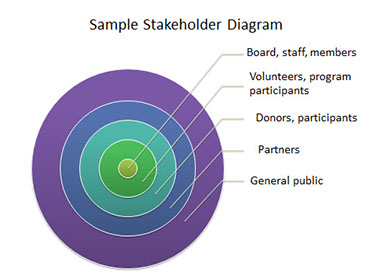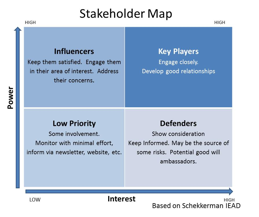Painting a Picture of Your Stakeholders
EXPLORE

© impact8, 2015
By Judy Hansen
As leaders in a non-profit organization, when we plan, request funding, confer with our board, we are often asked “What do your stakeholders think? Thoughtful analysis can give valuable insights.
This article presents several techniques to consider when analysing your stakeholder interests and needs. The sample charts and diagrams presented are catalysts for discussions to clarify thinking. Pick the methods which provide the most insight.
Who are Stakeholders?
Stakeholders include anyone with an interest in your non-profit organization and its work. Some are more important to your future than others. The stakeholders that affect organizational outcomes include the following obvious and not-so-obvious groups:
Represents multiple stakeholders, including consumers and the general public.
Can be harder to define. Can include recipients of services, volunteers, donors, funders, those who pay to attend seminars.
Volunteers are often critical to the success of your organization. Volunteers could include individuals who contribute time, money, talent and physical resources.
Private and public funders, individuals, sponsors and government bodies. Non-profit dependency on funders creates unique challenges. The funding picture may be unfamiliar to some Board members.
Collaborative partners can also be a challenge to define. Collaboration occurs in varied and innovative ways. In the non-profit world, another agency can be a collaborative support while competing for the same dollars, adding confusion to your stakeholder picture and analysis.
Other influential voices could include founders, former supporters, press, political representatives, governments, etc.
Stakeholder Analysis
Honing the list of who you serve and determining the role of various stakeholders can lead to some healthy strategic discussions at both the Board and staff levels. Consider the following 7 potential steps to stakeholder analysis:
1. Figure out who your stakeholders are and what influence they exert. For starters, making a simple list of your stakeholders groups can be an eye opener. Identifying your stakeholder relationships in a target or onion diagram (example on right) is another great place to begin.

2. Clarify which stakeholder group(s) you wish to analyse further and for which project/initiative. For your strategic plan? For a program? You might wish to separate internal (Board, staff) from external stakeholders (funders, clients).
3. Analyse the stakeholder power and impact on your organization. Use this analysis to prioritize and focus your efforts. Some questions to stimulate your thinking:
• How can we group our stakeholders? Stakeholder groups could include funders, members, or staff. Can you combine individuals, specific funders or specific members into a larger set of influencers?
• Why are they stakeholders? Are they important stakeholders?
• What support can we count on them to provide? Could be positive, neutral or negative.
• What influence do they have (high, low)?
Consider using a chart to help you compare groups. One example of a chart is a Stakeholder Map. For the visual picture provided by a Stakeholder Map, place the names of your Stakeholder groups into a two-by-two grid similar to the example on the right. The grid can be adjusted for alternative dimensions such as: power (as shown), support (positive, neutral, negative), influence (high or low) or need (strong, medium, weak). A third dimension can be created with different colours or symbols.
4. Ask strategic questions. Some sample strategic questions might be:

• Is there agreement on the priority clients that the organization should be serving?
• What environmental forces are your stakeholders addressing that could affect your future (positive or negative)?
• How can you further win the support of your most important stakeholders?
• How will you address a significant stakeholder shift, such as a major change after an election?
5. Develop your action plan. What are your plans regarding stakeholders? What organizational behaviours need to be encouraged? This step gives you the opportunity to question how you are going to involve your stakeholders and bring them closer. Realistically review your resources and figure out what is reasonable. If you are a beginner, simply understanding who the stakeholders are (previous steps) may be sufficient for advancing organizational thinking. The following chart can be used to develop your action plan regarding individual stakeholders.

6. Deliver on your action plan: Ensure that your stakeholders’ needs are met. Part of the action plan might be to conduct a stakeholder survey. That’s a topic for a separate article!
7. Review and update: Check in annually to ensure that your current analysis and actions are up to date and effective. Adjust and carry-on!
Hopefully this article has given you great ideas for painting a picture of your stakeholders and adjusting your plan to meet the needs of the key players and influencers in your non-profit world.
Author: Judy Hansen is a partner with impact8. 587-880-4714 or judy@impact8.ca
For more information or assistance in looking at your stakeholders: Contact one of our impact8 Inc professionals at.587-880-4708 connect@impact8.ca.
References
• Google Images for Stakeholder Analysis: https://www.google.ca/search?q=stakeholder+analysis&rlz=1C1FLDB_enCA572CA572&espv=2&biw=1920&bih=955&tbm=isch&tbo=u&source=univ&sa=X&ei=2xjZVLDIGZLxoASPqIDQBQ&ved=0CC8QsAQ
• NIEP Facilities Management Hub http://www.niepfmhub.org.uk/fm/business-case/developing-options/
• St. Louis Institute for Business Analysis: http://stlouis.iiba.org/index.php/resources/template
• Wikipedia: Stakeholder Analysis: http://en.wikipedia.org/wiki/Stakeholder_analysis
What does 'collaboration' mean?
Who owns a good idea?
Are good ideas born suddenly or do they have a development time?
If an organization seeks to solve big issues or problems in our society, can it do that alone?
Check out this TEDtalk that explores where good ideas come from:

